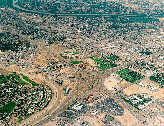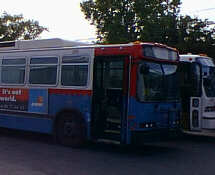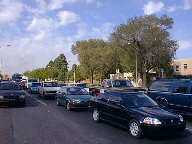 |
After World War II, which ended in 1945, Albuquerque grew enormously in both population and land area. The city property proper, that portion of the urban area within the city limit, grew from 35,000 people and 11 square miles in 1940, to 97,00 people and 48 square miles just ten years later. Then by 1996, the population reached 420,00 and the land area included 163 square miles.
Moreover, countless changes occurred in all the things that have to do with the physical form and the daily functioning of the city--economic activities, land uses, transportation facilities, the entire pattern of urban structure. Probably the one thing that everyone recognizes about Albuquerque is how scattered and decentralized the city is. As planners often say, Albuquerque is a low-density city, one having mostly one-story buildings and large areas of vacant land waiting to be developed.
This pattern was established early, well before mid-century, but it has continued to the present. In the 1950s and 1960s, most of the city's growth and development took place as sprawling residential subdivisions in the Northeast Heights, and most of the growth was hung on a grid pattern of major streets spaced a mile apart. With still more growth through the nineties, curvilinear streets at irregular spacing came into vogue, though some of the curved streets couldn't carry traffic as well as the grid had done.
In both cases, however, the pattern of growth depended heavily on the use of personal automobiles, not public transit. Albuquerque's growth was, after all, a thinly spread expansion to relatively inexpensive land, with the costs of operating automobiles making up the difference.
A related aspect of Albuquerque's modern growth was, and has been, the formation of first one and then another center of urban activity. The commercial and institutional focus of the original downtown did not simply expand like ripples on a pond, though there was some of that. Instead, there came to be well separated "nodes of employment" and areas that generated and received auto traffic, such as the University of New Mexico, one of the first, and--in more recent times--the shopping malls. Albuquerque started out with only a downtown and Old Town, but those were followed by University Heights/Nob Hill, then North Fourth Street and "East Central." Then came centers associated with Kirtland Air Force Base and Veterans Hospital and the airport. Later came the commercial node called Uptown, and then Far North, the Renaissance, Rio Rancho, North I-25 and most recently the Seven-Bar Cottonwood area. In almost every direction there has come to be some sort of commercial or institutional hub of activity, connected to the others by many miles of arterial streets and thousands of automobiles. Today, getting back and forth between these nodes and everywhere else requires Albuquerque residents to drive more than eleven million miles daily. Without exception, all these nodes were "leapfrog" developments.
A major theme of this article is that Albuquerque's growth is not the same thing as "economic development." The distinction is between "more" and "better." The best measure of economic development in a community or an area may be the question of whether there is a rising level of per capita income. Included in the question may be such matters as:
While Albuquerque has benefited in some aspects of urban life, its success is perhaps not all that it might have been.
Sheer growth of a city to larger size--just having more people--is not all bad, of course. Growth can bring significant net benefits, such things as larger museums, more theater, and better air transportation schedules. Eventually, however, unplanned or poorly planned growth can be counterbalanced by higher land and building rents, longer traffic delays, and increased air pollution, to name a few. In Albuquerque, economic development planning, in place of raw growth might have made for a better city.
Few would argue that Albuquerque's growth has not been mostly raw growth. Even the city's promotional activities have been largely indiscriminate, at least on the part of industrial development advocates.
State and local economic development policy-makers and planners, in Albuquerque and elsewhere, typically busy themselves in attracting jobs--any and all jobs--but often without long-range, comprehensive, economic development plans. In the absence of choosing preferred development paths with clearly identified targets and tools, land use and transportation planners are often placed in the uncomfortable and inefficient position of simply reacting to growth and of making commitments, including sinking large investments, without seeing clearly where they are going or quite knowing what they are trying to make or do.
Major decisions on a host of actions--school curricula, job training programs, transportation corridors, regional shopping centers, etc.--should follow from and support an economic development policy. Does a community intend to become a regional trade and service center, a national science center, a workshop for "advanced manufacturing" practices, a tourist mecca, or some special mix of "all of the above?" In Albuquerque the directions of growth are not abundantly clear.
Perhaps as reflection of this condition, the Albuquerque metropolitan area has not yet established itself as a major western metropolis in any economic sector. It is not, for example, a major wholesaling, warehousing, and trucking center in the way that Denver is. Albuquerque also lags well behind its competitors (Denver, Phoenix, Salt lake City) in high finance, management and engineering consulting, and other key "advanced services." It is not yet closing the gap, either. True, employment has grown faster than that sector has grown nationally, but that has been due almost entirely to the rapid growth of local population --the rapid growth of the local market.
Potential remains for Albuquerque, however. Throughout the post-WW II period, Bernalillo County has remained "high-tech," having from one-and-one-half times to twice the national average proportion of employment in engineering occupations. Clearly, at least in the eyes of some, the best development alternative to becoming a full-fledged regional metropolis is for not only Albuquerque but also the Los Alamos/ Albuquerque/Las Cruces corridor to enhance its position as a national center of science and engineering. To the degree that New Mexico sees this metropolitan corridor as more and more a world-class net of technology, the call will be for it to find its place in the global system of cities.
Next, a closer look is needed at what might be different if Albuquerque were to possess an agreed-upon economic development plan.
Local economic development depends importantly on the internal efficiency of the whole city, seen as an integrated production complex, with its structural form and paths of movement arranged in mutually supportive ways. The forms and paths of movement can, however, be varied. For example, national and even regional trade and service centers have long tended to build strong downtowns. Today, even though the larger metropolitan areas tend to have many centers (are "multi-nodal" like Albuquerque), commercial-financial cities are still inclined more toward high-density workplaces (tall office buildings), and the professional and managers who work there are more inclined toward high-density residential patterns (apartment living). And with more tightly clustered trip origins and trip destinations, transit is more efficient and therefore more commonly found.
The manufacturing city typically takes on a different urban form. Specialization in manufac-facturing makes for weak central business districts, poor and depopulating central cities, and auto-dominated transportation systems, struggling to handle cross-commuting between many outlying centers. If Albuquerque sees factories in its future, then its transportation and land use planners should foresee the very distinct urban form that that specialization produces. Meanwhile, and again speaking of the entire United States, the post-WW II era of rapid urban population growth is ending. Birth rates are falling and rural areas have about emptied out. Therefore many cities can now turn from accommodating growth to planning the "rearrangement of the furniture." While Albuquerque has been growing rapidly from the movement of population westward; it, too, is beginning to experience a slowing of growth. Herein can be a second chance to build the city. The next trip though, the rebuilding of the city, might well feature mixed-age buildings, mixed at finer grain, with redevelopment weaving in and out of the ruins and the remnants, rebuilding and restoring.
The good news of this is that balancing the age-mix of housing brings home and work closer together--by mixing high- and low-skill work with high- and low-priced housing. Age mixing of capital acts to reduce excessive movement; it balances tax bases and public-service needs; and it encourages social mixing.
 |
Next, what about transportation in cities such as Albuquerque, where densities are low and activity "starve" urban public transportation. Given the convenience, comfort and privacy of automobile transportation and the near-universal ability to afford a car (in part because its use is so heavily subsidized), we struggle, almost in vain, to attract riders to space-saving, environment-conserving transit.
One solution, at least, lies less in creating more capacity in the street and highway system and more in bringing origins and destinations closer together in space, changing land use patterns in ways that shorten trip distances and thereby accommodate more trips and more interactions with less movement.
This solution would be a matter of densities. Cities too often promise more public transit service that they can deliver. For example, Albuquerque's local public policy and posture implies that one can choose to live anywhere in the area and be served with good public transit on demand--a promise the public sector cannot keep as long as most of the population prefers automobile mobility. Rather than spending their transit money evenly across the whole area, cities should experiment with "thick subsidies for thin systems" to implant a stronger structure into those amorphous transportation systems and land-use patterns. The transit-preferring and the transit-dependent population would be asked--indeed, would be expected--to move near the guaranteed, high-quality, skeletal, low-fare system.
As part of this "social contract," the public sector would have to do strong land-use planning: perhaps invest in land, or tax capital gains in land, or subsidize housing costs near transit stops. Otherwise, rising land prices at the transit stops would quickly price the poor our of the easy-transit-access housing. The taxation of capital gains on nearby land, with the funds used to finance low-income housing along these routes of high public purpose would, for example, correct for such unintended side effects.
The City of Albuquerque'scurrently commissioned study of a light rail system is a small step in the right direction, but the larger step will come with gaining the support of the taxpayer. And the largest step will come when the city must "nudge" potential users into the designated corridors and talk drivers into helping finance the system by paying the social costs they impose by not using public transportation.
A lot of discipline is implicit in what has just been said about solving the transportation/density problem. In contrast, the problem might be said to have arisen from lack of discipline. If there were an Albuquerque city economist, he or she would argue that many of the city's problems were of its own making, created by treating urban space and movement and public services as "free goods." Lacking "public prices" to discipline the demand for more public services and public investment, the city finds itself with capital shortages, traffic congestion, air pollution, and strained public budgets. The city and county lack an overarching public price policy with which to guide raw growth into true urban economic development.
If, for example, the city had long ago adopted the practice of charging motorists the full (marginal) costs that the motorists impose on society, more road or bridge capacity would long ago have been built, or else not be needed, depending on whether the motorists would have been willing to pay the price (toll). Now that the federal government is becoming parsimonious, the funding of local transportation gets tougher. Toll-bridges and toll-ways, funded by revenue bonds, look better every day. If there were a little toll money left over, it could be used to subsidize buses for the poor, elderly, and handicapped.
 |
Usually even professional traffic studies contain implicit prices. Transportation planners tend to build models that are technically sophisticated but can become part of the environmental problem. Their traffic counts and origin-destination studies project investment "requirements" by asking people where and when they would like to drive, typically one at a time and "free." But economists become uncomfortable with the notion that the quantity of movement demanded at a zero price is a proper measure of the "demand" for transportation.
Finally for this brief analysis, another point or two may be mentioned about the relationship between sprawled residential development and transportation--about paying the costs of sprawl and the costs of growth. Prompted by rapid growth, the Albuquerque community has been struggling lately with the question whether the buyers of new houses should be charged "development impact fees." Charging the buyer of a new house most of the cost of the necessary public services is both fair and efficient. Newspaper editorials, however, have worried that these fees "could kill the boom," implying that the community looks forward to being a boom town. The editorials have worried also that development impact fees will push housing construction out into the perimeter, "creating urban sprawl." Sprawl would, in fact, be discouraged if the impact fees for most utilities, and for police and fire protection, were tailored for the real costs of delivering public services through space: higher fees for longer distances. Local newspapers would be well advised to support, not disparage, local planners trying to be good economists.
Moreover, guiding residential construction into new spatial patters, by carefully crafted housing impact fees, cannot but help generate the ridership needed to financially support transit. Full-cost development impact fees can indirectly promote a multi-modal transportation system.
(Up to Section V, Back to Historic Preservation, On to Landscaping)